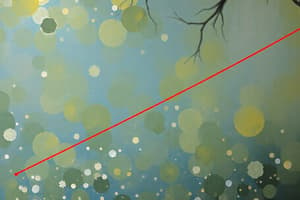Podcast
Questions and Answers
A country with a high GDP decides to invest significantly in improving its educational infrastructure and teacher training programs. What is the most likely long-term economic effect of this policy?
A country with a high GDP decides to invest significantly in improving its educational infrastructure and teacher training programs. What is the most likely long-term economic effect of this policy?
- A decrease in the country's potential GDP due to the immediate costs.
- An increase in the country's potential GDP due to a more skilled and productive workforce. (correct)
- A shift towards an economy based on natural resources rather than human capital.
- No significant change in the long-term GDP as education is not directly productive.
If a country experiences a surge in technological innovation, how would this likely affect its aggregate supply curve?
If a country experiences a surge in technological innovation, how would this likely affect its aggregate supply curve?
- The short-run aggregate supply (SRAS) curve would shift to the left.
- The long-run aggregate supply (LRAS) curve would shift to the left.
- Both the short-run aggregate supply (SRAS) and the long-run aggregate supply (LRAS) curves would shift to the right. (correct)
- The aggregate supply curves would remain unchanged as technology only affects aggregate demand.
Which of the following scenarios would be most likely to cause stagflation in an economy?
Which of the following scenarios would be most likely to cause stagflation in an economy?
- Increased automation in manufacturing leading to higher productivity and lower costs.
- A significant decrease in government spending on infrastructure projects.
- A supply shock, such as a sudden increase in the price of oil, combined with contractionary monetary policy. (correct)
- A rapid increase in consumer spending coupled with low unemployment.
A country removes tariffs and quotas on imported goods to foster free trade. What is a likely short-term consequence of this policy change?
A country removes tariffs and quotas on imported goods to foster free trade. What is a likely short-term consequence of this policy change?
If a central bank decides to increase the reserve requirement ratio for commercial banks, what effect would this likely have on the money supply and lending activity?
If a central bank decides to increase the reserve requirement ratio for commercial banks, what effect would this likely have on the money supply and lending activity?
What is the primary goal of contractionary fiscal policy, and which action exemplifies it?
What is the primary goal of contractionary fiscal policy, and which action exemplifies it?
Suppose a country is experiencing a recession. Which combination of fiscal and monetary policies would be most effective in stimulating economic activity?
Suppose a country is experiencing a recession. Which combination of fiscal and monetary policies would be most effective in stimulating economic activity?
If a country's unemployment rate is high and inflation is low, what type of policy would be most appropriate to improve its economic conditions?
If a country's unemployment rate is high and inflation is low, what type of policy would be most appropriate to improve its economic conditions?
How does an increase in government spending, financed by borrowing, potentially affect interest rates and private investment in the economy?
How does an increase in government spending, financed by borrowing, potentially affect interest rates and private investment in the economy?
What role do automatic stabilizers play in moderating economic fluctuations?
What role do automatic stabilizers play in moderating economic fluctuations?
How would a sudden and significant decrease in consumer confidence likely affect the aggregate demand curve?
How would a sudden and significant decrease in consumer confidence likely affect the aggregate demand curve?
If a country's central bank lowers its target inflation rate, what adjustments might it make to its monetary policy tools, and what would be the expected impact on the economy?
If a country's central bank lowers its target inflation rate, what adjustments might it make to its monetary policy tools, and what would be the expected impact on the economy?
A country decides to peg its currency to a stronger foreign currency. What are potential benefits and risks associated with this decision?
A country decides to peg its currency to a stronger foreign currency. What are potential benefits and risks associated with this decision?
In an open economy, how do changes in the exchange rate affect the trade balance, assuming the Marshall-Lerner condition holds?
In an open economy, how do changes in the exchange rate affect the trade balance, assuming the Marshall-Lerner condition holds?
What are the key differences between demand-pull and cost-push inflation, and what are their typical causes?
What are the key differences between demand-pull and cost-push inflation, and what are their typical causes?
How might quantitative easing (QE) by a central bank influence borrowing costs and investment in the economy?
How might quantitative easing (QE) by a central bank influence borrowing costs and investment in the economy?
What are the potential effects of a large influx of foreign direct investment (FDI) on a developing country's economy?
What are the potential effects of a large influx of foreign direct investment (FDI) on a developing country's economy?
How does an aging population structure impact a country's labor force participation rate and potential GDP?
How does an aging population structure impact a country's labor force participation rate and potential GDP?
What is the Laffer Curve, and what does it suggest about the relationship between tax rates and government revenue?
What is the Laffer Curve, and what does it suggest about the relationship between tax rates and government revenue?
Assuming that the expectations-augmented Phillips curve is accurate, what is the short-run tradeoff between inflation and unemployment, and how does it change in the long run?
Assuming that the expectations-augmented Phillips curve is accurate, what is the short-run tradeoff between inflation and unemployment, and how does it change in the long run?
Flashcards
What is a lease?
What is a lease?
A legal agreement granting temporary use of property or assets.
Who is a lessee?
Who is a lessee?
The individual or entity granted the rights to use property under a lease.
Who is a lessor?
Who is a lessor?
The individual or entity granting the rights to use property to a lessee.
What is a finance lease?
What is a finance lease?
Signup and view all the flashcards
What is an operating lease?
What is an operating lease?
Signup and view all the flashcards
What are minimum lease payments?
What are minimum lease payments?
Signup and view all the flashcards
What are the net investment in the lease?
What are the net investment in the lease?
Signup and view all the flashcards
What is a bargain purchase option?
What is a bargain purchase option?
Signup and view all the flashcards
What is the unguaranteed residual value?
What is the unguaranteed residual value?
Signup and view all the flashcards
What is the lease term?
What is the lease term?
Signup and view all the flashcards
What is a sales-type lease?
What is a sales-type lease?
Signup and view all the flashcards
What is a direct financing lease?
What is a direct financing lease?
Signup and view all the flashcards
What are leasehold improvements?
What are leasehold improvements?
Signup and view all the flashcards
What is the discount rate?
What is the discount rate?
Signup and view all the flashcards
What is an initial direct cost?
What is an initial direct cost?
Signup and view all the flashcards
Study Notes
- Correlation represents the degree of a linear relationship between two scale variables.
- It is used when you want to understand the strength and direction of a relationship between two variables, such as height and weight.
- Regression is used to predict the value of one scale variable based on the value of one or more other variables.
- It helps understand how much the dependent variable changes for every unit change in the independent variable(s).
Correlation Coefficient (r)
- The correlation coefficient, denoted as r, is a measure of the strength and direction of a linear relationship between two variables.
- Ranges from -1.0 to +1.0.
- The sign of r indicates the direction of the relationship: a positive value means a positive relationship, and a negative value means a negative relationship.
- The absolute value of r indicates the strength of the relationship.
- 0 indicates no linear relationship.
- 1 indicates a perfect linear relationship.
Types of Relationships
- Positive Relationship:
- Indicates that as one variable increases, the other variable also tends to increase.
- A correlation coefficient near +1.0 indicates a strong positive relationship.
- Negative Relationship:
- Indicates that as one variable increases, the other variable tends to decrease.
- A correlation coefficient near -1.0 indicates a strong negative relationship.
- No Relationship:
- Indicates that there is no linear association between the two variables.
- A correlation coefficient near 0 indicates no relationship.
Simple Linear Regression
- A statistical method used to model the relationship between one independent variable and one dependent variable.
- The goal is to find the best-fitting straight line (regression line) that describes how the dependent variable changes as the independent variable changes.
- The equation for simple linear regression is:
- Y = bX + a
- Y is the predicted value of the dependent variable.
- X is the value of the independent variable.
- b is the slope of the regression line.
- a is the Y-intercept (the value of Y when X = 0).
- Y = bX + a
Multiple Regression
- An extension of simple linear regression that allows you to predict a dependent variable based on multiple independent variables.
- The equation for multiple regression is:
- Y = b1X1 + b2X2 + ... + bnXn + a
- Y is the predicted value of the dependent variable.
- X1, X2, ..., Xn are the values of the independent variables.
- b1, b2, ..., bn are the coefficients for each independent variable.
- a is the Y-intercept.
- Y = b1X1 + b2X2 + ... + bnXn + a
Studying That Suits You
Use AI to generate personalized quizzes and flashcards to suit your learning preferences.



